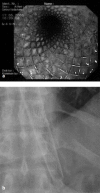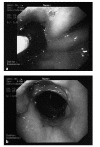[Postoperative complications after laparoscopic Roux-en-Y gastric bypass in bariatric surgery]
- PMID: 20124778
- PMCID: PMC6444587
- DOI: 10.1159/000198259
[Postoperative complications after laparoscopic Roux-en-Y gastric bypass in bariatric surgery]
Abstract
Der laparoskopische Roux-Y-Magenbypass weist eine Reihe charakteristischer chirurgischer KomplikationsmÖglichkeiten neben den in der bariatrischen Chirurgie generell vorhandenen Risiken auf. Durch die minimal-invasive Technik konnte das Risiko insgesamt vermindert werden. Die MortalitÄt betrÄgt 0–0,5%, das MorbiditÄtsrisiko betrÄgt zwischen 6 und 30%. Dabei erschweren die speziellen UmstÄnde des morbid adipÖsen Patienten hÄufig die Diagnosestellung, und insbesondere septische Komplikationen mit einem hohen MortalitÄtsrisiko stellen eine große Gefahr dar. GrÖßt mÖgliche Sicherheit und PrÄvention sind daher besonders wichtig. Die hÄufigsten Todesursachen sind Lungenembolie und Anastomoseninsuffizienz. Die hÄufigsten Komplikationen haben pulmonale und kardiale Ursachen. Wundkomplikationen werden als Folge des laparoskopischen Zugangssehrselten beobachtet. Chirurgische Komplikationen resultieren im Wesentlichen aus Blutungen, Problemen an den Anastomosen und NÄhten sowie dem DÜnndarm in Form von PassagestÖrungen unterschiedlicher Genese. Die chirurgischen wie bariatrischen Ergebnisse zeigen, dass das Ausmaß der FrÜh- und SpÄtkomplikationen im Vergleich zu den Folgeneiner fehlenden operativen Behandlung akzeptabel ist.
Postoperative Complications after Laparoscopic Roux-en-Y Gastric Bypass in Bariatric Surgery The laparoscopic Roux-en-Y gastric bypass surgery involves some characteristic surgical complications besides the general risks associated with bariatric surgery. The overall risk could be effectively decreased due to the minimal invasive technique, though. The mortality is 0–0.5% and the risk ofmorbidity varies between 6 and 30%. However, the specific circumstances of morbidly obese patients make diagnostics difficult. Especially septic complications of any kind represent a high risk ofmortality. Therefore, maximal safety und prevention are very important issues to consider. The most common causes of death are pulmonary embolismand insufficiency of anastomosis. Due to the laparoscopic approach complications of wound healing are scarcely observed. The most frequent complications result from pulmonary and cardiac dysfunctions. Surgical complications mainly result from bleedings, problems with the anastomoses and sutures as well as from the small intestine showing any kind of passage malfunction. Overall, the surgical and bariatric results reveal that early postoperative and long-term complications remain within tolerable limits when compared toconsequences of a lack of surgery.
Figures




Similar articles
-
Rate of Death and Complications in Laparoscopic and Open Roux-en-Y Gastric Bypass. A Meta-analysis and Meta-regression Analysis on 69,494 Patients.Obes Surg. 2016 Aug;26(8):1956-63. doi: 10.1007/s11695-016-2231-z. Obes Surg. 2016. PMID: 27189352 Review.
-
Overcoming the learning curve of laparoscopic Roux-en-Y gastric bypass: a 12-year experience.Surg Obes Relat Dis. 2013 Nov-Dec;9(6):867-72. doi: 10.1016/j.soard.2013.01.020. Epub 2013 Feb 11. Surg Obes Relat Dis. 2013. PMID: 23499192
-
Laparoscopic Roux-en-Y Gastric Bypass: Surgical Technique and Tips for Success.J Laparoendosc Adv Surg Tech A. 2018 Aug;28(8):938-943. doi: 10.1089/lap.2018.0393. Epub 2018 Jul 16. J Laparoendosc Adv Surg Tech A. 2018. PMID: 30010475
-
Comparison of Early Morbidity and Mortality Between Sleeve Gastrectomy and Gastric Bypass in High-Risk Patients for Liver Disease: Analysis of American College of Surgeons National Surgical Quality Improvement Program.Obes Surg. 2018 Sep;28(9):2844-2851. doi: 10.1007/s11695-018-3259-z. Obes Surg. 2018. PMID: 29696572
-
[Surgery for morbid obesity: 2. Complications. Results of a Technologic Evaluation by the ANAES].J Chir (Paris). 2003 Feb;140(1):4-21. J Chir (Paris). 2003. PMID: 12709648 Review. French.
Cited by
-
Propensity Score-Matching Sleeve Gastrectomy (SG) vs. Gastric Bypass (RYGB) in Patients ≥ 60 Years.Obes Surg. 2021 Jun;31(6):2682-2690. doi: 10.1007/s11695-021-05320-1. Epub 2021 Mar 4. Obes Surg. 2021. PMID: 33661453
-
[Internal hernias after bariatric surgery].Chirurg. 2015 Sep;86(9):855-60. doi: 10.1007/s00104-015-0046-4. Chirurg. 2015. PMID: 26319178 Review. German.
-
Impact of preoperative weight loss achieved by gastric balloon on peri- and postoperative outcomes of bariatric surgery in super-obese patients: a retrospective matched-pair analysis.Langenbecks Arch Surg. 2022 Aug;407(5):1873-1879. doi: 10.1007/s00423-022-02472-1. Epub 2022 Mar 8. Langenbecks Arch Surg. 2022. PMID: 35257223 Free PMC article.
References
-
- Courcoulas A, Perry Y, Buenaventura P, Luketich J. Comparing the outcomes after laparoscopic versus open gastric bypass: a matched paired analysis. Obes Surg. 2003;13:341–346. - PubMed
-
- Westling A, Gustavsson S. Laparoscopic vs open Roux-en-Y gastric bypass: a prospective, randomized trial. Obes Surg. 2001;11:284–292. - PubMed
-
- Marema RT, Perez M, Buffington CK. Comparison of the benefits and complications between laparoscopic and open Roux-en-Y gastric bypass surgeries. Surg Endosc. 2005;19:525–530. - PubMed
Publication types
MeSH terms
LinkOut - more resources
Full Text Sources
Medical
Research Materials
Miscellaneous

